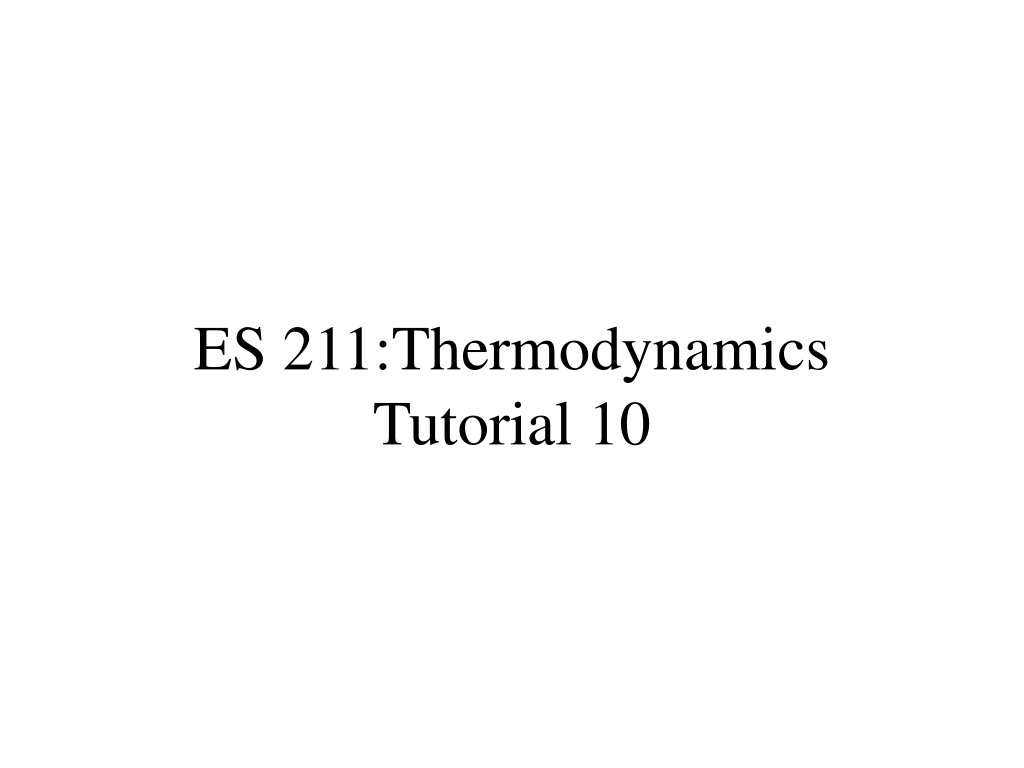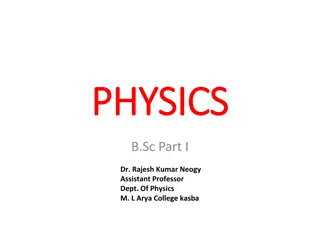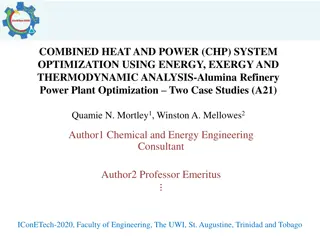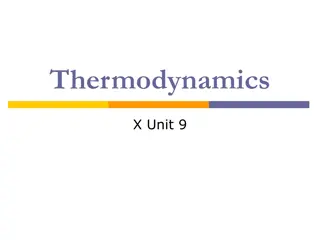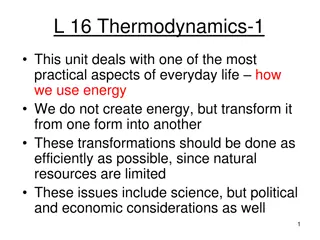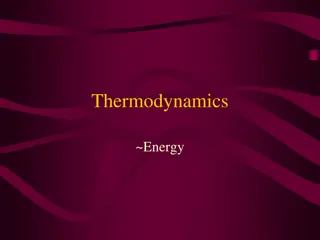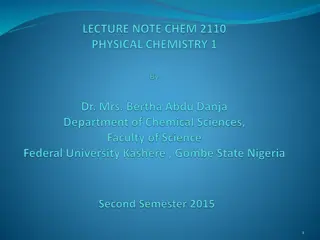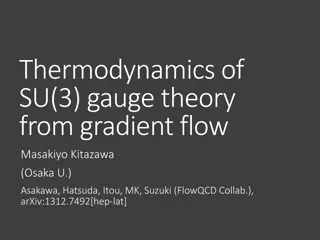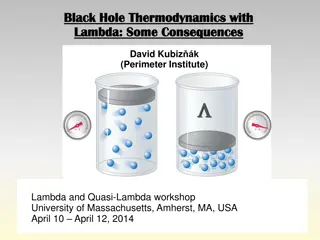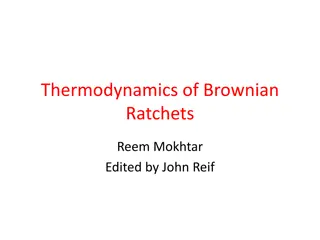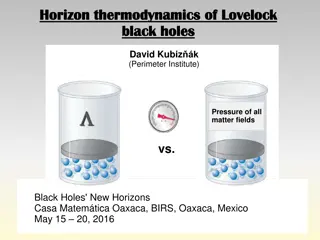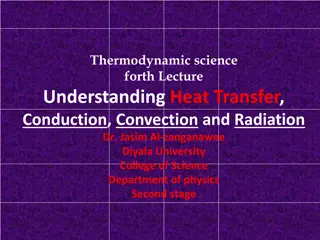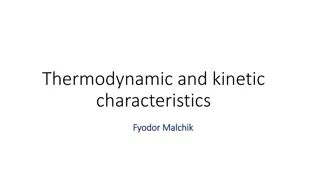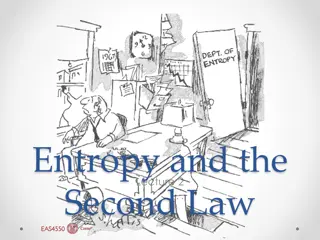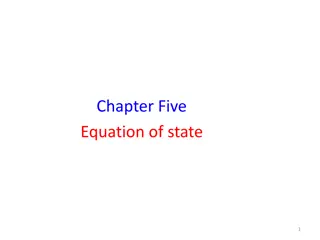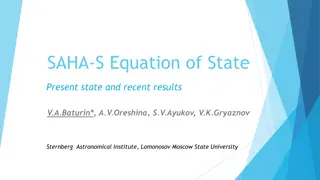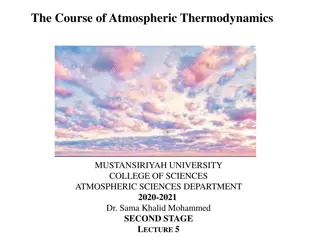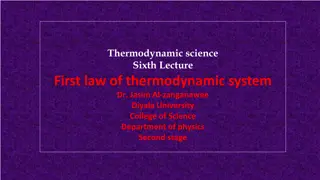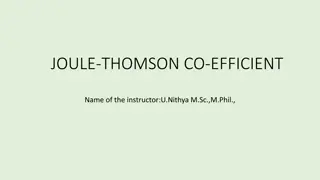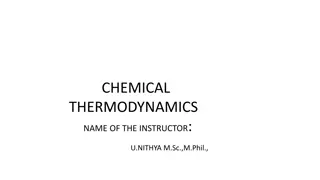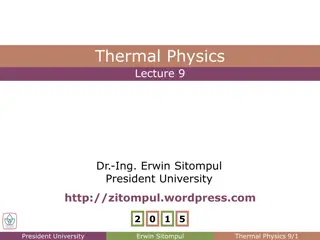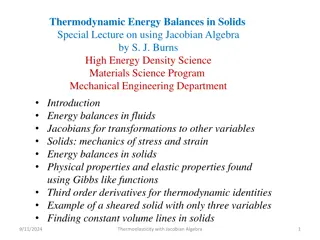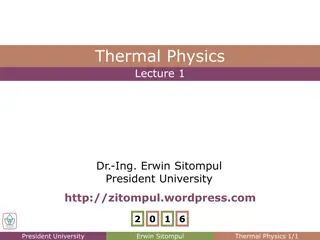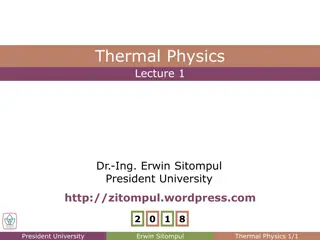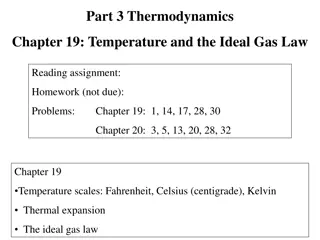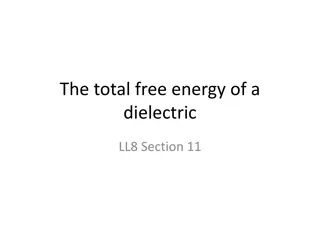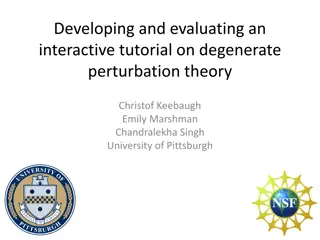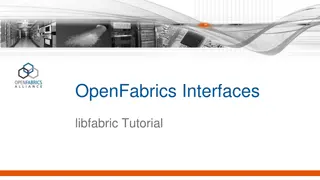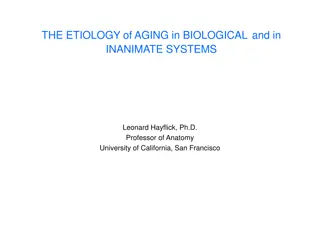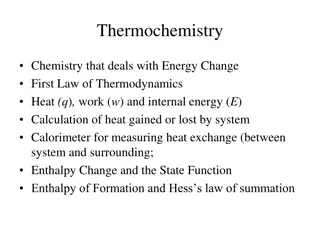Thermodynamics Tutorial: Exergy Analysis of Processes
In this tutorial, we delve into the analysis of thermodynamic processes through the concept of exergy. We explore the determination of exergy destroyed, reversible work, equilibrium temperatures, wasted work potential, and more in various scenarios involving insulated systems. Detailed calculations and explanations guide you through understanding the energy transformations and efficiencies within these systems.
Download Presentation

Please find below an Image/Link to download the presentation.
The content on the website is provided AS IS for your information and personal use only. It may not be sold, licensed, or shared on other websites without obtaining consent from the author. Download presentation by click this link. If you encounter any issues during the download, it is possible that the publisher has removed the file from their server.
E N D
Presentation Transcript
ES 211:Thermodynamics Tutorial 10
Q1 An insulated rigid tank contains 0.9 kg of air at 150 kPa and 20oC. A paddle wheel inside the tank is now rotated by an external power source until the temperature in the tank rises to 55 surrounding air is at T0=20oC, determine (a) the exergy destroyed and (b) the reversible work for this process. oC. If the
(a) The exergy destroyed during a process can be determined from an exergy balance, or directly from Xdestroyed = T0Sgen. We will use the second approach. But first determining the entropy generated from an entropy balance, S S S gen out in = + S system T V + = = + 0 ln ln 2 2 S S m c R gen system v T V 1 1 T = ln 2 S mc gen v T 1 Taking cv=0.718 kJ/kg oC and substituting, the exergy destroyed becomes: X destroyed T = = ln 2 T S T mc 0 0 gen v T 1 328 = 293 9 . 0 ( . 0 )( 718 ) ln 293 = 21 4 . kJ (b) The reversible work, which represents the minimum work input Wrev,in in this case, can be determined from the exergy balance by setting the exergy destruction equal to zero. X X X = X in out destroyed system
= W = X X , 2 1 rev in + ( ) ( ) ( ) E E P V V T S S 2 1 0 2 1 0 2 1 = ( ) ( ) U U T S S 2 1 0 2 1 Since KE= PE=0 and V2=V1. Noting that T0(S2-S1)=T0 Ssystem=21.4 kJ, the reversible work becomes T mc W v in rev 55 )( 718 . 0 ( 9 . 0 = = ( ) ( ) T T S 4 . S , 2 1 0 2 1 = 20 ) 21 ( 22 6 . 21 ) 4 . 2 . 1 = kJ Therefore, a work input of just 1.2 kJ would be sufficient to accomplish the process if all the irreversibilities were eliminated.
Q2 A 5-kg block initially at 350 oC is quenched in an insulated tank that contains 100 kg of water at 30 oC. Assuming the water that vaporizes during the process condenses back in the tank and the surroundings are at 20 oC and 100 kPa, determine (a) the final equilibrium temperature, (b) the exergy of the combined system at the initial and the final states, and (c) the wasted work potential during this process.
(a) Noting that no energy enters or leaves the system during the process, the application of the energy balance gives: E E E = = in out system 0 U = + 0 ( ) ( ) U U iron T ( water [ + = 0 [ )] ( )] mc T mc T T f i iron f i water By using specific heat values for water and iron at room temperature, the final equilibrium temperature Tf becomes: T f 7 . 31 = . 0 ( 5 = + 0 45 )( 350 ) 100 ( )( . 4 18 )( 30 ) T f o T C f (b) For an incompressible substance exergy X can be calculated by: = + ( ) ( ) ( ) X U U T S S P V V 0 0 0 0 0 T = + ( ) ln 0 mc T T T mc 0 0 T 0 T = ln mc T T T 0 0 T 0
Where T is the temperature of the specified state and T0 is the temperature of the surroundings. At the initial state: = 623 ( 5 . 0 45 ) ( 623 293 ) ( 293 ) ln X , 1 iron 293 = 245 2 . kJ 303 = 100 . 4 ( 18 ) 303 ( 293 ) ( 293 ) ln X , 1 water 293 = 69 8 . kJ = + = 315 X X X kJ , 1 , 1 , 1 total iron water Similarly, the total exergy at the final state is = 5 . 0 = X kJ 1 . + , 2 iron 95 X kJ 95 , 2 water = = 5 . 0 1 . 95 6 . X kJ , 2 total (c) Xdestroyed can be calculated as follows: X in 0 = X X = X out destroyed system X X X = 2 1 destroyed = = 315 95 6 . 219 4 . X X X kJ 1 2 destroyed
Q3 An ideal Otto cycle has a compression ratio of 8. At the beginning of the compression process, air is at 100 kPa and 17 oC, and 800 kJ/kg of heat is transferred to air during the constant-volume heat addition process. Accounting for the variation of specific heats of air with temperature, determine (a) the maximum temperature and pressure that occur during the cycle, (b) the net work output, (c) the thermal efficiency and (d) the mean effective pressure for the cycle.
(a) Determining the temperature and pressure of air at the end of the isentropic compression process: 290 1 = = = 206 91 . / T K u kJ kg 1 676 1 . rv 1 Process 1-2 (isentropic compression of an ideal gas): v v r 11 . 475 2 = 1 676 1 . v v = = = = = = 84 51 . 652 4 . 2 2 1 r r v T K 2 2 r 8 v r r 1 1 / u kJ kg P V 2 P V 1 T V = = 2 1 2 1 P P 2 1 T T T V 2 1 1 2 652 4 . = = ) 8 ( 100 1799 7 . kPa 290 Process 2-3 (constant-volume heat addition) = in u q u 3 u 2 = 800 u 475 kJ 11 . / kJ kg 3 = = 1275 = 11 . / 1575 1 . kg T K 3 3 . 6 108 v 3 r
P V 3 T P V 2 V = = 3 3 2 2 P P 3 2 T T T V 3 2 2 3 1575 1 . 7997 . 1 = = ) 1 ( . 4 345 MPa MPa 652 4 . (b) Process 3-4 (isentropic expansion of an ideal gas): v v r 74 . 588 4 = v = = = . 6 ( 8 = = = 108 ) 48 864 . 795 6 . 4 4 r r v rv T K 4 3 4 r r v 3 3 / u kJ kg Process 4-1 (constant volume heat rejection): q out 588 = = = u u q u 381 u 83 . 1 4 4 1 out 91 . = 74 . 206 / q kJ kg out , Thus = = = = 800 381 83 . 418 17 . / w q q q kJ kg net net in out (c) Thermal efficiency of the cycle is determined from its definition: 1 k = = = ) 8 ( = 1 k 1 1 1 . 0 565 r 4 . 1 1 , th Otto 1 r = 56 5 . %
(d) The mean effective pressure is determined from its definition: w MEP 1 w w = = = net net net / 1 / 1 ( 1 ) v v v v r v r 2 1 1 , where . 0 287 ( 290 ) RT = = = 3 . 0 832 / 1 v m kg 1 100 P 1 , Thus 418 17 . = = 574 MEP kPa / 1 . 0 832 1 ( ) 8
Q4 An ideal Diesel cycle with air as the working fluid has a compression ration of 18 and a cut off ration of 2. At the beginning of the compression process, the working fluid is at 100 kPa, 27 oC and 1917 cm3. Utilizing the cold-air- standard assumptions, determine (a) the temperature and pressure of air at the end of each process, (b) the net work output and the thermal efficiency and (c) the mean effective pressure.
(a) Determining the volume at the end of each process: 1917 V = = = 106 5 . 1 V cm 3 2 18 r = = = 3 ( 2 106 ) 5 . 213 V r V c cm 3 2 = = 3 1917 V V cm 4 1 Process 1-2 (isentropic compression of an ideal gas) V T T 1 2 1 k = = = 300 18 ( ) 953 1 K 4 . 1 1 V 2 1 k V = = = 100 18 ( ) 5720 1 P P kPa 4 . 1 1 2 1 V 2 Process 2-3 (constant pressure heat addition to an ideal gas): P P 5720 2 3 = = kPa P V 3 V P V 2 = = = = 3 3 953 ) 2 ( 1906 2 T T K 3 2 T T V 2 3 2 Process 3-4 (isentropic expansion of an ideal gas)
1 k 4 . 1 1 213 V = = = 3 1906 791 T T K 4 3 1917 V 4 1 k 4 . 1 1 213 V = = = 3 5720 264 P P kPa 4 3 1917 V 4 (b) The net work for a cycle is equivalent to the net heat transfer. But first we find the mass of air: V P m ( 287 . 0 1 6 3 100 1917 ( 10 ) m = = = 00223 . 0 1 1 kg 300 ) RT Process 2-3 is a constant pressure heat addition process, for which the boundary work and u terms can be combined into h: h h m Q in . 1 )( 00223 . 0 ( = = = ( ) ( ) mc 1906 )( T T 3 2 3 2 P = 005 953 ) . 2 136 kJ Process 4-1 is a constant volume heat rejection process and the amount if heat rejected is:
= = ( ) ( ) Q = m u . 0 ( u mc 791 T 300 T ) 4 1 4 1 out . 0 V 00223 718 )( = . 0 786 kJ , = Thus = . 1 = . 2 136 . 0 786 35 W Q Q kJ net in out Then the thermal efficiency becomes . 1 35 W = = = . 0 632 net th . 2 136 Q in = 63 2 . % (c) The MEP is determined by: W W = = = 746 net net MEP kPa V V V V max min 1 2
